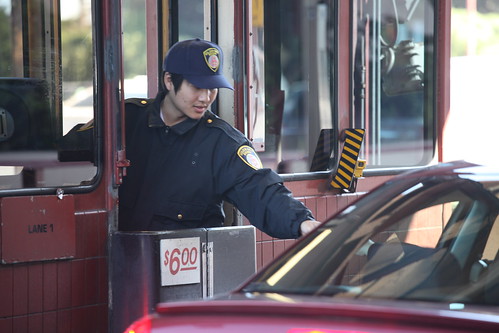
The majestic Golden Gate Bridge has been a San Francisco icon for 75 years, but the toll workers will soon become obsolete to its day-to-day operations.
The bridge will no longer have human toll collectors as early as December 2012, changing to an all-electronic system in an effort to close part of the approximately $90 million budget deficit over the next five years.
“We can expect all the bridges in the Bay Area to have all-electronic tolling in a number of years,” Metropolitan Transportation Commission spokesman John Goodwin said.
According to a study conducted by architecture management firm Howard, Needles, Tannen and Bergendoff, automated tolling systems increase toll efficiency within each lane from 200 to 400 vehicles per hour per lane to 2,200 vehicles, the efficiency of a free-flowing highway.
In addition to increasing efficiency, the automated system is expected to reduce traffic congestion and pollution by relying on FasTrak transponders and cameras to snap photos of vehicle license plates and send drivers who don’t have transponders a toll invoice. Commuters will be able to register their vehicles’ license plates linked to a valid credit or debit card account for toll payment and will receive the bill at the end of the month.
This change, however, is projected to save just $16 million over the next 10 years, according to Mary Currie, spokeswoman for the Golden Gate Bridge, Highway and Transportation District.
Toll bridges around the nation have adopted this system. In the last two years, eight U.S. toll agencies have adopted the all-electronic tolling system, including Denver’s E-470, Northwest Parkway in Denver and all North Texas Tollway facilities, according to the architecture management firm’s study.
Although the Golden Gate Bridge sees an average of 110,113 vehicle crossings per day, according to a Bridge District survey of vehicles from 2010 to 2011, John Moylan, a member of the Golden Gate Bridge District’s Board of Directors, believes the new system will not reduce traffic as effectively as projected.
“Traffic on Golden Gate Bridge is a little less than the Bay Bridge,” said Moylan. “But is it going to become faster? I don’t think so.”
Moylan also believes that terminating the 32 toll collectors will rob the bridge of its friendly feel. He stepped down from a committee created specifically for the implementation of the all-electronic tolling out of solidarity with the toll workers because he didn’t want to contribute to the loss of jobs and be linked with the committee’s decision, he said.
“These toll workers are well-respected goodwill ambassadors,” said Moylan, who was the only opposing vote in the 18-1 decision to implement the automated system. “And I just don’t feel good about eliminating people.”
Moylan said the only other way the district may have been able to raise revenue is either by charging pedestrians to walk across the bridge or to increase the toll fares.
“I can see that happening eventually,” he said.
Ronald Austin, executive vice president of the San Francisco chapter of the Transport Workers Union of America, said they have been in contact with other unions around the Bay Area to see if there are available positions elsewhere for the toll workers.
Implementing the new system will leave workers out of jobs, but Currie said the district hopes to place those workers in other positions within the organization.
Toll collectors offered alternate positions will receive first priority, if eligible, for positions such as diesel mechanics or bus drivers with the Golden Gate Ferry or Golden Gate Transit system. But there are no guarantees.
Those who have yet to relocate to another position will receive settlement packages, Currie said.
Toll collectors declined to comment.
Ashley Castaneda, a junior liberal studies major at SF State, uses the bridge regularly to get to her job in Sausalito and thinks it’s unfortunate that these changes will affect the toll workers.
“I think it’s sad that they are going to lose their jobs,” said Castaneda. “But I don’t see how (the Bridge District) can get around it.”
Though this automated system is meant to solve a mounting budget problem, Moylan believes the district won’t be saving as much as they hope to.
“The main reason we’re cutting workers is to save money,” he said. “But I don’t think it will be saving us much overall.”



